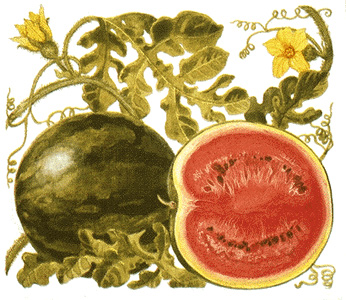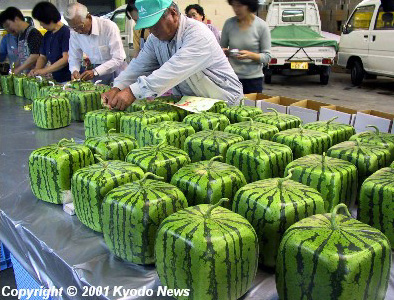Watermelon is a large, sweet fruit. It has a smooth rind (hard outer skin) and juicy, edible flesh. Most watermelons have seeds. Growers also produce seedless types. Watermelons may have a round, oval, oblong, or blocky shape. The rind is striped or solid in color. It can be various shades of green or grayish-green, with darker stripes. The flesh of ripe watermelons may be white, yellow, orange, pink, or red. People often classify watermelon cultivars (varieties) by weight. The smallest fruits weigh less than 12 pounds (5.4 kilograms). The largest weigh more than 32 pounds (14.5 kilograms). Record weights exceed 250 pounds (113 kilograms).

Watermelons are about 93 percent water. They are a good source of vitamins A and C. They also provide lycopene, a chemical that may help reduce the risk of cancer. People generally eat the watermelon fruit fresh. But they also eat the seeds. Cooks pickle the rind to make relish. People use the fruit in syrup and even cattle feed.

Watermelons grow on vines. The plants require a long growing season. They mature in 75 to 100 days. Growers plant the seeds about 4 feet (1.2 meters) apart in rows spaced about 6 to 8 feet (1.8 to 2.4 meters) from one another. In cold weather, seeds are often planted in a greenhouse first. They are then transplanted into fields after the danger of frost has passed. Growers also transplant all seedless cultivars of watermelons.
Watermelon vines, or runners, can grow 40 feet (12.2 meters) long or more. They produce slender, coiling tendrils and yellow blossoms. The tendrils attach themselves to objects in the field. Watermelon fruit develops from pollinated flowers. When a watermelon ripens, the rind color becomes dull. The top of the fruit flattens slightly. Ripe watermelons make a dull, hollow thud when thumped.
A fungal disease called Fusarium wilt is the main disease of watermelon plants. The wilt fungus remains in the soil. It may infect new plants for several years. Growers control wilt by rotating the watermelon crop to a different field each year. They also may plant cultivars resistant to the disease. Watermelons also suffer from viruses, roundworms, insects, spider mites, and other pests. Farmers combat these problems with chemical pesticides and with pest-resistant cultivars.
The watermelon plant probably originated in western or southern Africa. China has cultivated the fruit for more than 1,000 years. China ranks as the top watermelon-producing country. Other major producers include Turkey, Iran, and the United States.
